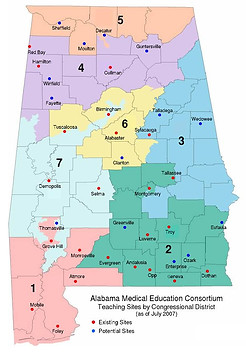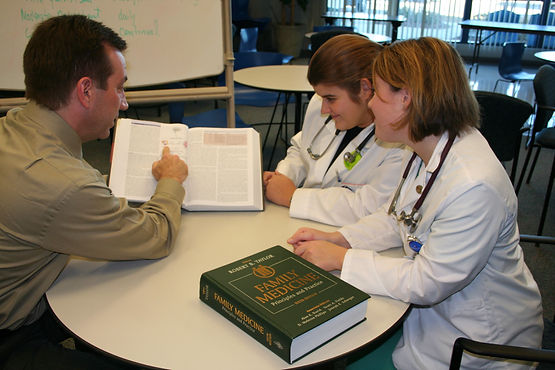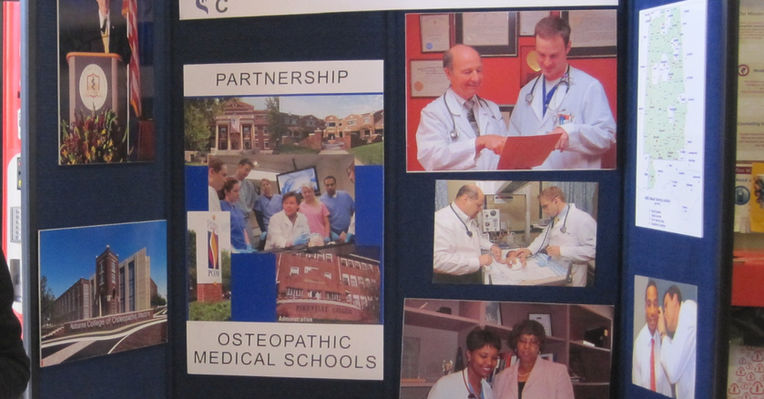
Alabama Medical Education Consortium
AMEC's History
The vision of those who structured the Alabama Medical Education Consortium (AMEC) was that a new model for training physicians would begin the process to increase physician manpower in the State. Particularly in the waning years of the 20th century, many groups struggled with ideas to give better access to health care for all Alabama’s people but especially to those in areas that were critically underserved. After some trial and error, a group agreed on starting an entity that would become a physician pipeline – osteopathic medical students would be trained in community based locations for their third and fourth years. Statistically, physicians tend to practice near where they train; with this data in mind, the concept was that about 70% of locally trained students would eventually provide medical care to Alabamians.


AMEC became the vehicle through which the Pipeline functioned. In 2006 AMEC received its first funding from the Alabama Legislature. By 2015, over 375 medical students had matriculated in the core sites in Alabama; 324 became physicians; the last class of AMEC Pipeline students will completed residency in 2019; as of 2019, 102 former AMEC students are licensed in Alabama in more than 35 cities. An unintended consequence of the AMEC Pipeline’s success was the building of the Alabama College of Osteopathic Medicine in Dothan. ACOM assumed responsibility for the core sites created by AMEC; the number of core sites has increased from 12 to 29 in the State.
Core Sites - 2007
Core Sites - 2019
As early as 2009, as the Pipeline became a working reality, it was recognized that having those AMEC students and others do their residency in Alabama would further enhance the possibility that more physicians would practice in the State. After a number of “think tank” discussions, AMEC prepared a strategic plan to increase residency opportunities in Alabama. Today that plan is being funded by the State; first funding was received in FY 2017 to provide assistance for start-up of new Graduate Medical Education in up to 12 Alabama hospitals.
AMEC presented its Graduate Education Proposal to the governor who included funding in his recommended budget for 2017. Following consultants' advice, each hospital would be funded up to $300K to start developing its GME program. In 2018 two programs were accredited by the American Council for Graduate Medical Education (ACGME) and have since successfully matched for each residency class. A third and fourth program were accredited and began recruiting in 2019. Altogether ten programs have received Accreditation from the ACGME; and five others are actively engaged in starting new residency programs. AMEC was also funded in the State 2018 and 2019 budgets. When all the programs are fully developed, as many as 400 new GME slots may be expected for Alabama. A real plus in physicians for our State!
Throughout its history, AMEC has been motivated by its mission and vision, based on data, for growing the number of physicians in our State. First the mission addressed medical students – focus was developing the core sites, quality preceptors, and physicians well-grounded in the art and science of medicine (the human touch) in a productive climate that would encourage them to practice in Alabama. Assisting hospitals to develop new GME programs, and providing tuition scholarships provides a full spectrum of “how to grow your own.”


A special thank you to Dr. Kenneth McLeod who originated the idea of bringing medical students into Alabama for their 3rd and 4th year clerkships. From that idea evolved the "medical school without walls" and eventually the Alabama College of Osteopathic Medicine.
The Pipeline was the manifestation of Dr. McLeod's idea, becoming the symbol of AMEC's mission. Our thanks to Dale Quinney for constructing the Pipeline.

Thank you to the people who have contributed so much to the formation, design and implementation of the Alabama Medical Education Consortium.
Dr. Wil Baker consolidated the thoughts and suggestions of numerous people for the pipeline idea. He was joined by Ruth Harrell and Lucy Sowell in the Spring of 2006. Mrs. Harrell retired in December 2011; Mrs. Sowell retired in January 2012.
Chris Finerty became the office assistant in 2012 and worked with AMEC for 4 1/2 years. Lee Timberlake was hired in 2008 to manage the financial aspects of AMEC, and she has served in that capacity and as administrative director since 2012.
AMEC's successful endeavors are due to these people in addition to others who have contributed expertise to the Consortium. We're grateful for their service to AMEC's ongoing mission.

AMEC's
History in Pictures







































